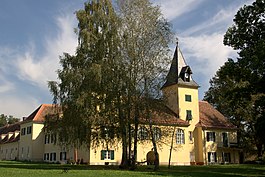Thal, St. Gallen
| Thal | ||
|---|---|---|
 |
||
|
||
| Coordinates: 47°28′N 9°34′E / 47.467°N 9.567°ECoordinates: 47°28′N 9°34′E / 47.467°N 9.567°E | ||
| Country | Switzerland | |
| Canton | St. Gallen | |
| District | Wahlkreis Rorschach | |
| Government | ||
| • Mayor | Robert Raths | |
| Area | ||
| • Total | 9.61 km2 (3.71 sq mi) | |
| Elevation | 415 m (1,362 ft) | |
| Population (Dec 2015) | ||
| • Total | 6,426 | |
| • Density | 670/km2 (1,700/sq mi) | |
| Postal code | 9425 | |
| SFOS number | 3237 | |
| Surrounded by | Fußach (AT-8), Gaißau (AT-8), Heiden (AR), Höchst (AT-8), Horn (TG), Lutzenberg (AR), Nonnenhorn (DE-BY), Rheineck, Rorschacherberg, Wasserburg (Bodensee) (DE-BY), Wolfhalden (AR) | |
| Website |
www SFSO statistics |
|
Thal is a village and municipality in the Wahlkreis (constituency) of Rorschach in the canton of St. Gallen in Switzerland. Besides the village of Thal itself, the municipality also includes the villages of Altenrhein, Buechen, Buriet and Staad.
Thal is first mentioned in 1163 as curtis tale.
The 1983 UCI Road World Championships (cycling) took place in Altenrhein, a village in the municipality.
Thal has an area, as of 2006[update], of 9.6 km2 (3.7 sq mi). Of this area, 44% is used for agricultural purposes, while 13.1% is forested. Of the rest of the land, 35.8% is settled (buildings or roads) and the remainder (7.2%) is non-productive (rivers or lakes).
The municipality was part of the Unterrheintal District, but in 2004 became part of the Rorschach Wahlkreis. It is located between the Appenzell foothills, the Buchberg and Lake Constance. It consists of the haufendorf village (an irregular, unplanned and quite closely packed village, built around a central square) of Thal and (since 1803) the villages of Altenrhein, Buechen, Buriet, Staad and a number of scattered hamlets.
In the North and East, the municipality borders the old bed of the Rhine river (Alter Rhein) and Austria.
The blazon of the municipal coat of arms is Argent a Grape Azure slipped embowed and leaved Vert.
Thal has a population (as of 31 December 2015) of 6,426. As of 2007[update], about 18.9% of the population was made up of foreign nationals. Of the foreign population, (as of 2000[update]), 112 are from Germany, 188 are from Italy, 417 are from ex-Yugoslavia, 93 are from Austria, 42 are from Turkey, and 181 are from another country. Over the last 10 years the population has grown at a rate of 5.5%. Most of the population (as of 2000[update]) speaks German (91.3%), with Albanian being second most common ( 2.0%) and Italian being third ( 1.8%). Of the Swiss national languages (as of 2000[update]), 5,475 speak German, 23 people speak French, 110 people speak Italian, and 9 people speak Romansh.
...
Wikipedia




